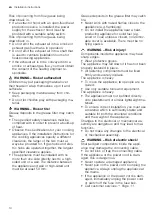
en
Troubleshooting
10
3.
Use a brush to clean the grease filters.
4.
Rinse the grease filters thoroughly.
5.
Allow the grease filters to drain.
9.6 Cleaning grease filters in the
dishwasher
The grease filters filter the grease from the cooking va-
pour. Regularly cleaned grease filters guarantee a high
level of grease removal. We recommend cleaning the
grease filters every two months.
WARNING ‒ Risk of fire!
Fatty deposits in the grease filters may catch fire.
▶
Clean the grease filters regularly.
ATTENTION!
The grease filters may become damaged if they are
squeezed.
▶
Do not squeeze the grease filters.
Note:
When cleaning the grease filter in the dish-
washer, light discolouration may occur. This discoloura-
tion has no effect on the performance of the metal
grease filters.
Requirement:
The grease filters have been removed.
1.
Observe the information regarding the cleaning
agents.
2.
Place the grease filters loosely into the dishwasher.
Do not clean heavily soiled grease filters with
utensils.
Use special grease solvent for stubborn dirt. You
can obtain grease solvents from after-sales service
or the online shop.
3.
Start the dishwasher.
Select a temperature of no more than 70 °C.
4.
Allow the grease filters to drain.
9.7 Fitting the grease filters
1. ATTENTION!
Falling grease filters may damage the hob below.
▶
Grip below the grease filter with one hand.
Note:
Note the correct position of the grease filter.
Insert the grease filter.
2.
The lock on the grease filter clicks into place.
3.
If the grease filter has been inserted incorrectly,
carefully push the lock forwards, remove the grease
filter and insert it correctly.
10 Troubleshooting
You can rectify minor faults on your appliance yourself.
Read the troubleshooting information before contacting
after-sales service. This will avoid unnecessary costs.
WARNING ‒ Risk of injury!
Improper repairs are dangerous.
▶
Repairs to the appliance should only be carried out
by trained specialist staff.
▶
If the appliance is defective, call Customer Service.
WARNING ‒ Risk of electric shock!
Incorrect repairs are dangerous.
▶
Repairs to the appliance should only be carried out
by trained specialist staff.
▶
Only use genuine spare parts when repairing the
appliance.
▶
If the power cord of this appliance is damaged, it
must be replaced by the manufacturer, the manufac-
turer's Customer Service or a similarly qualified per-
son in order to prevent any risk.
10.1 Malfunctions
Fault
Cause and troubleshooting
The appliance is not
working.
The mains plug of the power cord is not plugged in.
▶
Connect the appliance to the power supply.
The circuit breaker in the fuse box has tripped.
▶
Check the circuit breaker in the fuse box.
There has been a power cut.
▶
Check whether the lighting in your kitchen or other appliances are working.






































